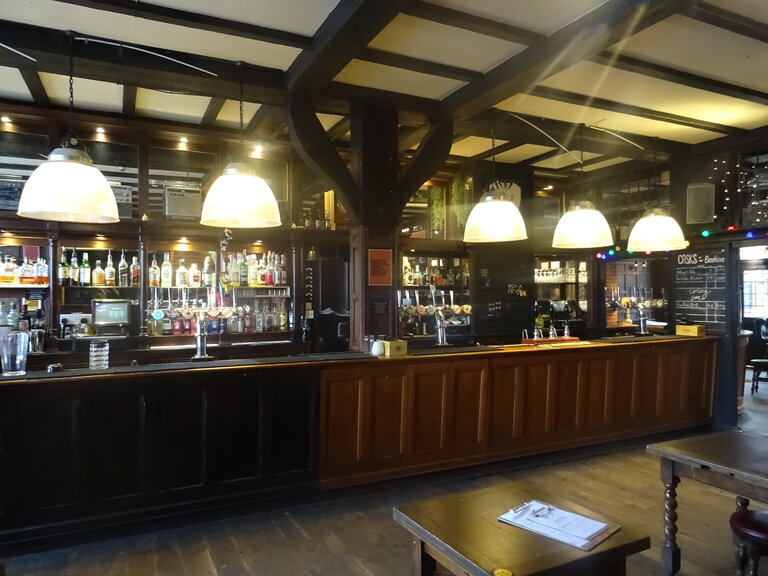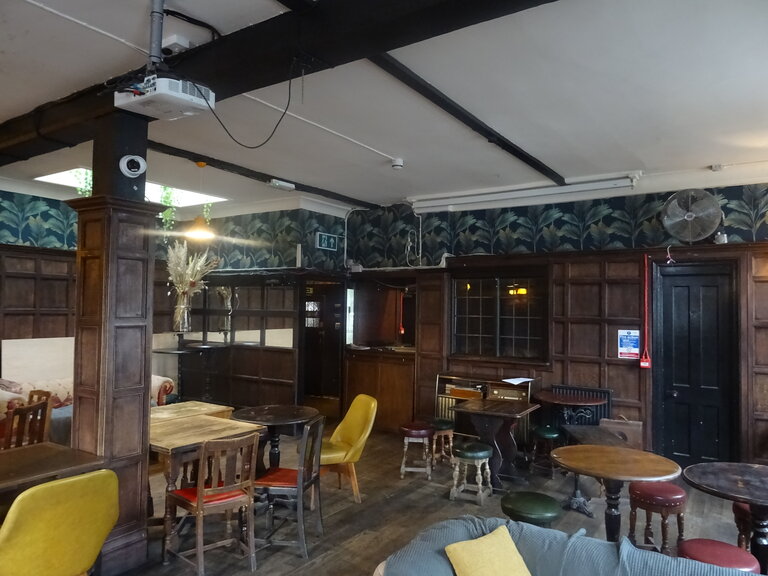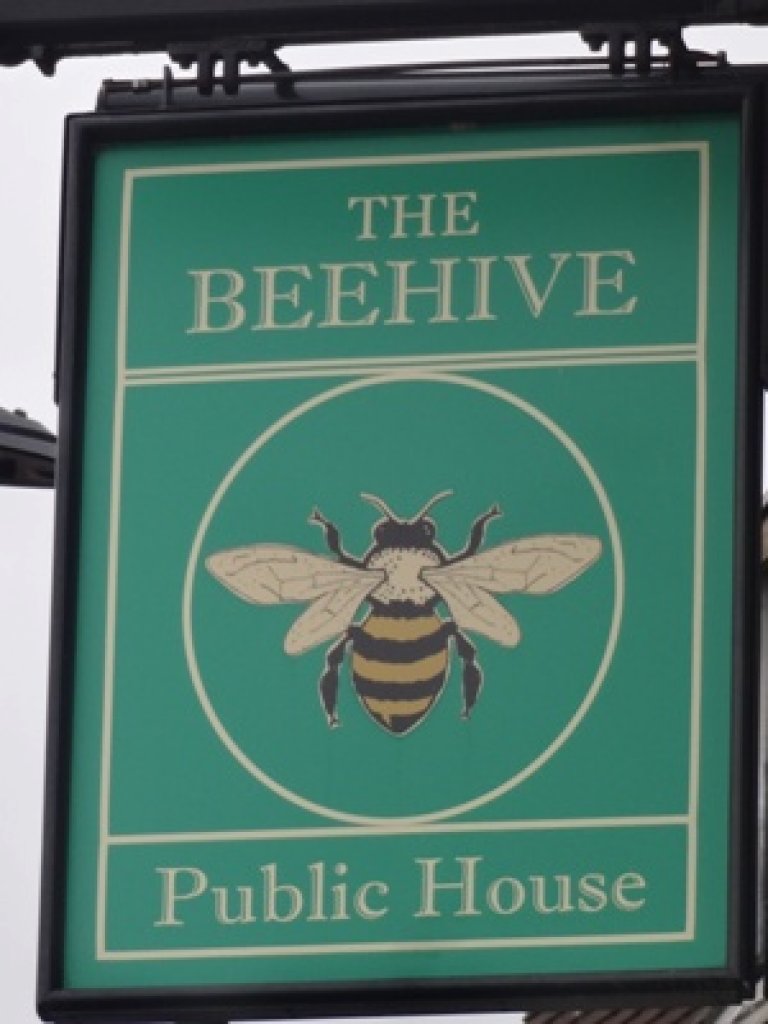Beehive
Stoneleigh RoadTottenham
N17 9BQ
This pub is not only a grade II listed building, it is also a One Star pub on the Campaign for Real Ale’s (CAMRA) National Inventory with an interior of special national historic interest, and the description is as follows: “The Beehive is a purpose-rebuilt public house of the inter-war period, dating from 1927. A fine example of an unspoilt “Brewer's Tudor” pub. The designer is not known. The old layout is complete (apart from the removal of a screen) and you can fully appreciate how such a pub was meant to appear. On the left corner doors have ‘Public’ and ‘Bar’ leaded panels in them. The Public bar has fielded panelling to picture frame height (the “wooden panelling” actually being an imitation to help create the Tudor effect). It retains its original L-shaped panelled counter, original mirrored bar back, baffles by the doors, three of the original benches and two cased-in dart boards. Until 2012 behind the servery was a glazed-in office but the glazing has been replaced by wood. A front door has ‘Off License’ in a leaded panel and the off-sales is still intact with a small bar counter, but no longer in use. Another front door has a ‘Saloon Lounge’ in stained and leaded glass panel and through a vestibule is a spacious Baronial style right-hand room complete with mock original beams, more fielded ‘panelling’ to picture frame height and splendid light fittings. On the bar back in the lounge on the left there is some new wood and new tiles, the rest of the mirrored bar back is the original with a dumb waiter in the middle. There is a large red-brick fire surround on the rear wall i.e. in the ‘saloon lounge’ part and another at the end of the’ luncheon room’ part; The sliding screen that used to divide the Saloon Lounge (front) from the Luncheon Room (rear) has been removed but the glazing above it still remains. In the passageway is a door with a leaded panel ‘Self Service Room’, a rare if not unique room name (presumably linked to buffet-style food supply). It leads to a room used for darts and functions with more fielded ‘panelling’, modest skylight and a 1930s brick fireplace. Attractive brass door furniture throughout. Note that in this pub each door seems to have been numbered (up to 20 in the luncheon room) e.g. ‘14’ on Luncheon Room door to ladies toilet – something not seen in any other pub. It was standard practice to number rooms in pubs until the 1960s (as required for control purposes by Licensing Magistrates / Customs & Excise, but individual doors is another matter. A further curiosity is the fact that the ‘wooden’ panelling is nothing of the sort – feel it and tap it and you will find it is an imitation to create a Tudor effect on the sly.”
The listing description is as follows: “Public house. 1927 replacing a Victorian public house on the site. Architect and brewery unknown.
PLAN: Main frontage to Stoneleigh Road. From the west; public bar; off licence (no longer in use); lounge bar (originally partitioned from the single storey luncheon room facing the garden to the rear); panelled passage from front of the building through to a single-storey function room (known as the Self Service Room) at the east rear.
EXTERIOR: Designed in the Olde English Style often referred to as 'Brewers Tudor' and which was at its height of popularity in the 1920s and 30s. This was designed to reflect romantic notions of 'Merrie England' and was applied to pubs in town and country throughout England. Two storeys with attic. Half-timbered first floor, front elevation with large central gable and dormer to the east. Tall, red-brick, chimney stack piercing the tile roof to the west with exposed diaper brickwork. Square-headed timber casement windows throughout, those to ground floor with dimple-glass lights. Metal bracket to pub sign with date of 1927. Ground floor with tiled front (now overpainted). Doors with multi-paned lights above and with stained glass signs. The treatment to the rear is unusual with the saloon bar extended as a single storey towards the beer garden with a battlemented brick balustrade to a terrace (probably private although reached by an external metal stair) above French windows and a tower-like projection containing toilets.
INTERIOR: The interior is notable for the extent of survival of original features. The rooms all have the original Tudor-style small-square panelling to picture-rail height (this is an interesting imitation wooden panelling with an applied textured surface on a plywood base used to reproduce a Tudor effect without the cost of real wood) and lead-paned windows. Vernacular style brick chimney pieces, that in the Luncheon Room having herringbone brickwork and a brass hood decorated with a Tudor rose. The public bar retains its original L-shaped panelled counter, mirrored bar back, three original benches and two cased-in dart boards. Off-licence has a small serving counter. The lounge bar/luncheon room has its original brass light fittings, panelled bar counter, most of the original glazed bar back, imitation beams and the glazed upper part of the sliding screen separating the saloon from the luncheon room. The stained glass skylight is probably of more recent date. The doors to the 'Public Bar', 'Off-Licence', 'Saloon & Lounge', 'Luncheon Room' and 'Self Service Room' all have original stained glass signs. A very rare feature of the doors is that all seem to have been numbered (several of the brass numbers survive). Numbering of individual rooms within a pub was standard practice for Customs & Excise control purposes until the 1960s but this is the only known example of numbering for each door. The glazed office behind the public bar is another rare survival.
HISTORY: There is reputed to have been a public house called the Beehive on the block off Tottenham High Road, on the north side of Stoneleigh Road (until the middle of the C20, this was Balthazar Road), since the late 1870s. It first appears in the 1881 census when a Mr Evans lived there with his wife and eight children, with the address given as 'Stoneley South' (Stoneleigh Road then joined Balthazar Road at the junction with the High Road)and it appears on the 1894 Ordnance Survey map. The present building dates from 1927 according to a date on a metal bracket adjoining the pub sign and first appears on its present footprint in the 1936 OS map. The pub was extended to the north and east at this date with the enlargement of the saloon bar, creation of the beer garden and addition of the 'Self Service Room'. The building was originally flanked to the east by a row of four houses extending to Circular Road which ran north-south slightly further east of the current north-south section of Stoneleigh Road (and slightly west of its route today). These buildings were presumably demolished following damage from a parachute mine which fell in September 1940 and destroyed much of the area immediately south and east of the pub, necessitating the new post-war road layout. The remains of the chimney of the adjoining house can be seen behind the post-war garages.
The Beehive is a typical example of the 'improved' public houses that began as a reaction to the excesses of the late-Victorian gin palace at the end of the C19 and were built in large numbers in the inter-war period and seeking to give a more respectable image to drinking establishments. To this end they provided a wide range of facilities including function rooms, restaurant areas and gardens aimed at attracting a better class of customer, including women following the social changes wrought by the First World War. Around a quarter of existing public houses were remodelled or rebuilt between 1920 and 1939 and the Beehive is an urban example of this trend.
SOURCES: Pubs - Understanding Listing (English Heritage booklet - 1994) Brandwood, G, Davison, A, and Slaughter, M, - 'Licensed to Sell: the History and Heritage of the Public House' (2004) Brandwood, G, and Jephcote, J, - 'London Heritage Pubs: an Inside Story' (2008) pp.113-114
REASONS FOR DESIGNATION: The Beehive public house is designated at Grade II, for the following principal reasons: * For its rare survival of the interior of a medium-size 1920s urban 'improved' pub, including off licence and function room * Notable original internal features including glazed office, stained glass door signs, fireplaces, imitation Tudor panelling, bar counter, brass light fittings and a probably unique Customs & Excise door numbering system * Characteristic 'Brewers Tudor' exterior with an unusual terrace to the rear.”
The WhatPub link is here: WhatPub/Beehive
The Pub Heritage Group link is here: PHG/Beehive
The Beehive featured on the Daytime Crawl of North London on 15 October 2005, and the Ant and Bee: Daytime Crawl of Tottenham and Stoke Newington on 13 February 2016.
 Exterior
Exterior
 Lounge
Lounge
 Lounge Servery
Lounge Servery
 Public Bar
Public Bar
 Pub Sign
Pub Sign
